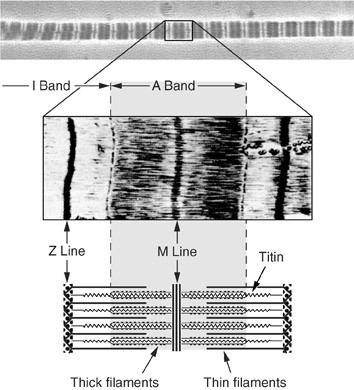Explain The Sliding Filament Theory
Definition
According to the sliding filament theory, musculus contraction occurs through the relative sliding of ii sets of filaments (actin and myosin). This sliding is produced by cyclic interactions of sidepieces from the myosin filament (cantankerous-bridges) with specific sites on the actin filament. Each such interaction is associated with a cantankerous-bridge power stroke whose energy is derived from the hydrolysis of adenosinetriphosphate (ATP), one ATP per cross-bridge bike.
Characteristics
Prior to the 1950s, muscle contraction and force production was associated with the shortening of myosin filaments. Myosin filaments can be seen with microscopy as the dark bands (the so chosen A-bands) in the striation pattern typical for skeletal and cardiac musculus (Fig. 1).

Micrograph of a series of sarcomeres from an unmarried myofibril (top panel), an isolated sarcomere bordered past the z-lines and containing myosin (or thick filaments) in the A-band region and actin...
References
-
Huxley AF, Niedergerke R (1954) Structural changes in musculus during contraction. Interference microscopy of living muscle fibres. Nature 173:971–973
-
Huxley HE, Hanson J (1954) Changes in cross-striations of muscle during contraction and stretch and their structural implications. Nature 173:973–976
-
Huxley AF (1957) Muscle construction and theories of contraction. Prog Biophys Biophys Chem 7:255–318
-
Huxley HE (1969) The mechanism of muscular wrinkle. Science 164:1356–1366
-
Huxley AF, Simmons RM (1971) Proposed mechanism of force generation in striated muscle. Nature 233:533–538
-
Rayment I, Holden HM, Whittaker Chiliad, Yohn CB, Lorenz M, Holmes KC, Milligan RA (1993) Structure of the actin-myosin complex and its implications for muscle wrinkle. Science 261:58–65
-
Rayment I, Rypniewski WR, Schmidt-Bäse Chiliad, Smith R, Tomchick DR, Benning MM, Winkelmann DA, Wesenberg G, Holden HM (1993) Three-dimensional structure of myosin subfragment-1: a molecular motor. Science 261:50–58
-
Ford LE, Huxley AF, Simmons RM (1977) Tension responses to sudden length alter in stimulated frog musculus fibers most slack length. J Physiol (London) 269:441–515
Author data
Authors and Affiliations
Editor information
Editors and Affiliations
Rights and permissions
Copyright information
© 2009 Springer-Verlag GmbH Berlin Heidelberg
About this entry
Cite this entry
Herzog, West. (2009). Sliding Filament Theory. In: Binder, M.D., Hirokawa, North., Windhorst, U. (eds) Encyclopedia of Neuroscience. Springer, Berlin, Heidelberg. https://doi.org/x.1007/978-three-540-29678-2_5463
Download citation
- .RIS
- .ENW
- .BIB
-
DOI : https://doi.org/ten.1007/978-three-540-29678-2_5463
-
Publisher Proper noun: Springer, Berlin, Heidelberg
-
Print ISBN: 978-three-540-23735-8
-
Online ISBN: 978-3-540-29678-ii
-
eBook Packages: Biomedical and Life Sciences Reference Module Biomedical and Life Sciences
Explain The Sliding Filament Theory,
Source: https://link.springer.com/10.1007%2F978-3-540-29678-2_5463
Posted by: bowyerhunhis.blogspot.com



0 Response to "Explain The Sliding Filament Theory"
Post a Comment